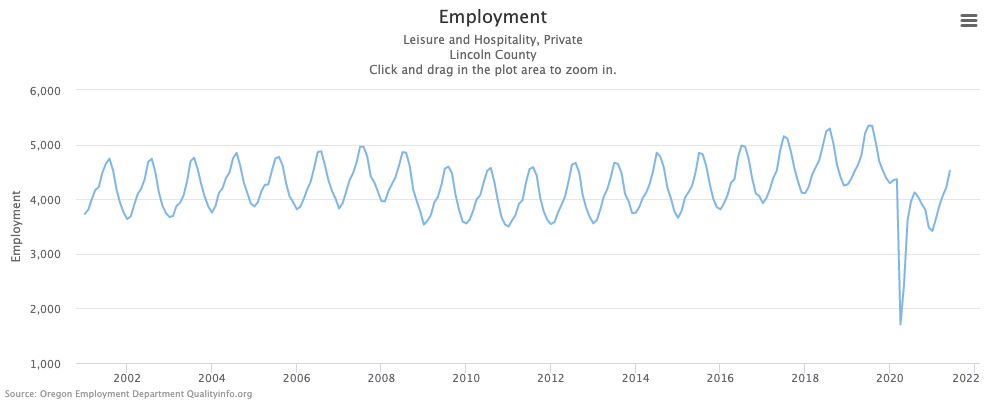
By QUINTON SMITH/YachatsNews.com
The state economist who focuses on the Oregon coast has come up with a number that documents the hit that the tourism industry and its workers took during the coronavirus pandemic last year.
And as you might expect, it’s not pretty. The good news – it’s improving rapidly, but not fully.
Spending by visitors to the five counties that make up northwest Oregon fell by 42 percent in 2020 when compared with 2019, said Erik Knoder, regional economist for the Oregon Employment Department. Visitor spending in the five counties during 2020 fell to $953 million.

Visitor spending had been increasing since 2011 until the pandemic recession struck and businesses were curtailed in March of 2020, he said. The 2020 decline followed growth that had averaged about 3 percent per year since 2011.
“The region had seen drops in spending before, such as during the 2008-10 recession, but nothing compared with the collapse in 2020,” Knoder wrote in a report this week.
The state agency monitors all kinds of employment and economic data for the five counties in northwest Oregon, including Lincoln, Benton, Tillamook, Clatsop and Columbia.
The leisure and hospitality is the largest industry in the five-county region, providing 13,300 payroll jobs in 2020, Knoder said, or about 15 percent of all jobs — excluding the self-employed – in the region.
Visitor spending peaked in 2006 at $1.37 billion and then fell 2 percent the next year. It was up and down during the 2008-10 recession and recovery. It fell to $1.29 billion in 2011, Knoder said, and climbed until the pandemic hit in 2020 when travel and lodging restrictions took effect and many tourism businesses closed or dramatically reduced hours or offerings.

In Lincoln County, visitor spending peaked in 2019 at nearly $630 million before dropping to $410 million in 2020, according to Knoder. Payroll jobs in the hospitality industry went from a high of 5,350 in June 2019 to 1,700 in April 2020, when severe pandemic restrictions on businesses and travel started.
Knoder said employment in the hospitality industry provides some insight into how visitor spending is faring in 2021.
“It’s improving rapidly but is still not completely recovered,” he wrote.
Employment in the five counties dropped an unprecedented 55 percent from March to April 2020. Employment this April was 100 percent higher than the year before, Knoder said, but it remained 14 percent lower than in April 2019 – the last year before the pandemic recession.
Knoder believes that the long-term outlook for visitor spending is good. The leisure and hospitality industry’s employment for the five counties in northwest Oregon is expected to grow 44 percent from 2020 to 2030, he said, based on the expectation that the industry recover to its former level.
After that, the industry’s employment will probably grow at a little less than 1 percent per year.
A major unknown factor will be how the pandemic recession and subsequent tight labor market will affect adoption of labor-saving technology and business practices, Knoder said. Businesses may also be more likely to implement service models, such as take-out food, that allow them more flexibility in adapting to any future pandemic.




Why is it that neither the state economist nor chambers of commerce nor county commissioners nor city councils ever give us the important figures — net benefits or losses? Yes, tourism revenues declined, but perhaps local expenditures incurred by tourists also declined. Same for when we hear about the benefits of tourism — we get only gross revenues — not the costs of policing, garbage collection, sewage treatment, etc. Nor do we ever get the indirect costs — time lost in traffic, traffic accidents. Nor do we ever see who gets the benefits. (E.g. if a motel chain gets $1 million in profits, how much stays in the county? The people who do our accounting tell us only that tourists brought in $X million, not what the motel chain took out.)
And when counting wages paid we never hear whether low wage workers also impose costs on local services or if minimum wage jobs are a net benefit to the county at all.
Or do we ever get a picture of the historical trend in taxes and how local taxes are impacted by tourism or any development? We often hear that X or Y increases the tax base and brings new jobs. We never see the trend in taxes paid. Have we seen anywhere in the US where increased tourism and development have lowered taxes?
I take no position on tourism and development, but how can anyone take an informed position on such when the accounting is done by Pollyanna?